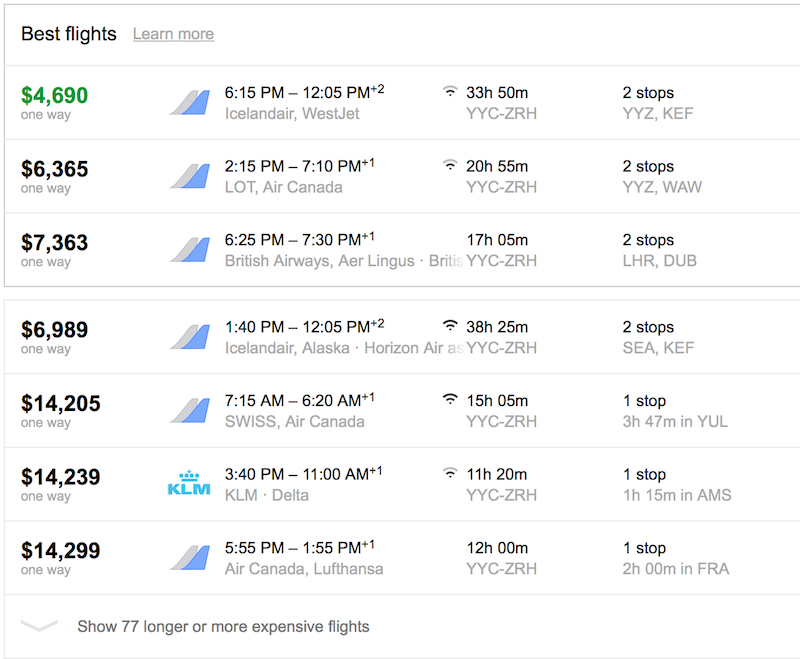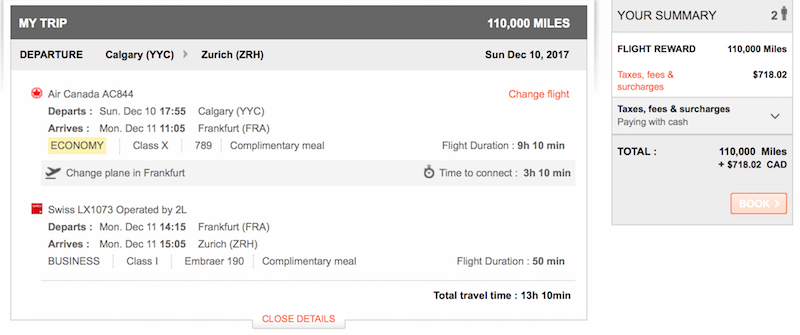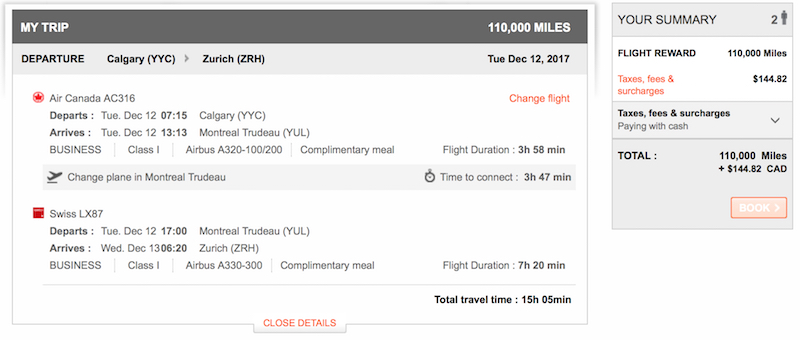Objective
Learn the basics of reward travel trip planning and understand the difference process compared to paid travel to maximize your chances of booking the best itinerary.
Learning Outcomes
- Understand the difference in thinking required when booking reward travel compared to paid (revenue) flights/hotels
- Know the best practices for planning reward travel including:
- Steps to take when planning
- How to choose the best rewards program with respect to your preferred destination
- When to book time off work in the trip planning process
- When to book hotels in the trip planning process
Suggested Prerequisites
- The Beginner’s Guide To Travel Hacking
- Using Google Flights To Search Route Networks
- How To Search Star Alliance Award Space
- How To Search Oneworld Award Space
- Understanding Airline Alliance And Partnerships
Introduction
Many people plan paid travel the same way:
- Choose a destination
- Schedule time off work
- Book flights
- Book hotels
- Book any nonrefundable aspects (tickets/tours/transfers etc)
While this strategy can work for reward travel, there are ways to increase your chances of finding the best flights or hotels by taking the same steps in a different order:
- Choose a destination
- Earn the required points (if you don’t have them)
- Book your flights
- Book your hotels
- Schedule time off work
- Book any nonrefundable aspects (tickets/tours/transfers etc)
While it doesn’t look much different on the surface, booking your flights and hotels before you schedule time off work will make a world of difference in searching for reward flights. While it doesn’t seem like much, being flexible in your departure/arrival dates by +/- one day will greatly increase your odds of scoring the best routes. If you can be flexible by a week on either side, you can almost be guaranteed a great route to almost any destination.
Advance Planning – Why It’s Important
While this may seem like a no-brainer, I still get a lot of people who expect to be able to find tickets to Europe over summer holidays for their family of four. Generally speaking, advanced planning is required for:
- Complex, multi-destination trips
- Trips for more than 2 passengers
- Trips to very popular destinations over peak periods (Europe in the summer)
- Trips to destinations with limited route networks (Australia/South Pacific) from North America
A lot of passengers unfamiliar with the industry don’t understand why they can’t use points for a flight that still has seats available. Many believe there are three levels of tickets: first class, business class, and economy. While this is kind of true, there are actually several sub-categories within each cabin class called ‘fare codes’.
Fare codes are the way revenue management optimize ticket sales, and are incredibly complicated for beginners. For example, first class alone may have 3 different fare codes:
- Full fare first class (Fare code ‘F’)
- Discounted first class (Fare code ‘A’)
- Award Level First Class (Fare code ‘O’)
While you may be able to search Google Flights and find first class seats available for sale on a particular route, this will not be reflective of the award seat availability, as these will be either fare level ‘F’ or ‘A’
The reality is that award ticket availability is complex, and completely at the mercy of each airline’s revenue management department. Each airline has different policies, which aren’t really publicly available, though airlines follow specific trends that can make the process less frustrating. Here are some well known trends to consider when planning:
- Most airlines release partner award space one year in advance
- Many airlines release more award space ‘last minute’, which can be from anywhere between 24 hours and 30 days
- Lufthansa first class only becomes available to partner airlines two weeks prior to departure
- Swiss Airlines first class is not available to partner airlines at anytime
- Singapore Airlines doesn’t offer premium cabin availability to partner airlines (with the exception of some routes in Asia)
- Cathay Pacific usually releases two business class seats one year out, with more available closer to departure. First class availability is not released in advance with any consistency and very difficult to book well in advance
- Cathay Pacific first class is very easy to book within 2 weeks of departure with a bit of flexibility
- Some airlines will release more space for travel on their own aircraft. As an example, Air Canada will sometimes make seats available for passengers using Aeroplan that wont be bookable using other Star Alliance programs such as United Airlines Mileage Plan
- Premium cabin travel on Qantas and Air New Zealand is notoriously difficult to find
- Air China, EVA Air, ANA, Turkish Airlines, Cathay Pacific, Japan Airlines, Hainan Airlines, Emirates, and United Airlines are generally quite generous with award availability in all cabin classes
- American Airlines is notoriously stingy with award seats on long-haul flights on their own aircraft (not applicable to partner award space)
Planning Your Flights
Undoubtedly the most difficult part of award travel is the planning and booking process. Many people are accustomed to going to an online travel website or travel agency and saying ‘I want to go here on these dates’ and are presented a set of options.
Award travel is slightly more complicated… While any destination is available on points, where/when/how you want to travel will impact your strategy for booking. Before starting this process, I strongly recommend everyone be familiar with the basics of route planning by completing the following courses:
Using Google Flights To Search Route Networks
Understanding Airline Alliances and Partnerships
How To Search Star Alliance Award Space
How To Search Oneworld Award Space
Once you know where you want to go, you need to figure out how to get there from where you live. This is where Google Flights comes in. Google Flights is great at filtering route networks based on origin, destination, cabin class, and total travel duration. Keep in mind Google is only being used to plan route networks and is not indicative of award space.
Let’s consider an example of a couple wanting to vacation in Zurich from Calgary (a less serviced Airport will always require a bit more planning than a large airport) without specific travel dates, but knowing they want to travel in December before the winter holidays.
First, I would go to Google Flights and plug in my search criteria. For the sake of usability, I suggest planning one-way at a time. If you are able to find an outbound route there will be a similar route inbound. Also, leave all of the filters blank on your initial search to populate the most routes between your origin and destination.

For this particular route, 84 results were found with multiple airlines and different connecting airports.

Now, based on your preferences, you can adjust all of the filters you want to limit number of stops, total travel duration, etc. Play around with it a bit, and try some alternative dates around your preferred departure. Some airlines only offer specific routes on certain days of the week or seasonally. Using Google flights to plan route networks will give you a good knowledge base of which destinations are serviced directly, or what alliances/partnerships make the best connections from your point of origin. If you’re underwhelmed with the results, try some nearby airports. You’ll be surprised at how quickly you gain a basic understanding of route networks by using this tool to do some random searches!
Choosing The Best Program To Use
Ok – the hard part is done. You know you want to visit Zurich from Calgary, and you have a solid understanding of the routes that can get you there. Based on your search you see two options that look good:
- Calgary to Zurich via Amsterdam on KLM Royal Dutch Airlines, a SkyTeam member
- Calgary to Zurich via Montreal on Air Canada and Swiss Airlines, both Star Alliance members
While the first option has a shorter overall travel duration with less time on connection in Amsterdam, you know as a Canadian earning miles with a SkyTeam partner is difficult outside of travel on a partner airline. On the other hand, Star Alliance flights can be booked with Aeroplan, and Aeroplan is one of the easiest points currencies to earn in Canada through flights, hotel stays, car rentals, credit card spending, and online shopping portals. You decide that the route with Star Alliance partner airlines will be more achievable using points.
Now that you’ve decided where you want to go and how you want to get there, you will now need to find the availability. This is where having some flexibility with your travel dates will be important. Like really important. If you limit yourself to one departure date and one arrival date, you are going to be very limited in using reward points and will not likely find the best seats, unless you’re planning a year in advance.
If in this example we limited our departure date to December 10th only, the best available business class flight with Star Alliance would be this flight via Frankfurt on Air Canada and Swiss, with the transatlantic segment in economy. Yuck. Oh, and look at the taxes and fees… This is what many Canadian’s are used to seeing when trying to redeem points. No wonder the process can be discouraging.

If we open up our availability to +/- 3 days from December 10th, we find our preferred flight via Montreal on Air Canada and Swiss, all in business class, with very minor surcharges. Success!

Once Your Flights Are Booked
Booking your reward flights will be the part of trip planning that requires the most flexibility, so I always suggest that as a starting point. Once your flights are confirmed and ticketed, go ahead and start planning the other parts of your trip:
- Hotel Booking*
- Scheduling Time Off Work
- Non-Refundable Tickets/Tours
- Airport Transfers
*If you’re using rewards for hotel bookings, keep in mind many programs allow you to book rooms with points that are fully flexible and cancellable. In the event you’re visiting a very popular destination (think Greek Islands over summer), you could book your hotel before your flights are confirmed to ensure you get a room, and modify as needed in the event you can’t secure flights on your preferred travel dates. This also works with paid stays – just make sure you read the cancellation policy in advance of booking as some rates don’t allow for changes and require full pre-payment, and some cancellation policies are strict during peak travel periods.
Scheduling time off work after booking travel can be tough for some, as I know many employers require advance notice for vacation time to be booked, and other factors like seniority can come into play. If you fall into this category, you just need to plan a bit further in advance. If you know your employer requires 6 months notice for time off, you’ll need to start earning points and researching flights well in advance of your expected travel dates. Admittedly, reward travel is a lot easier for people with flexibility in their travel dates, though still possible for those with rigid vacation schedules.
